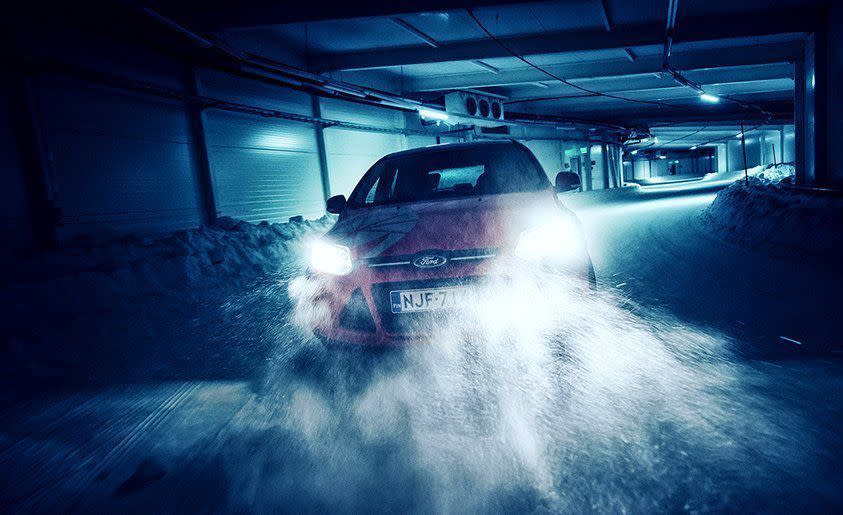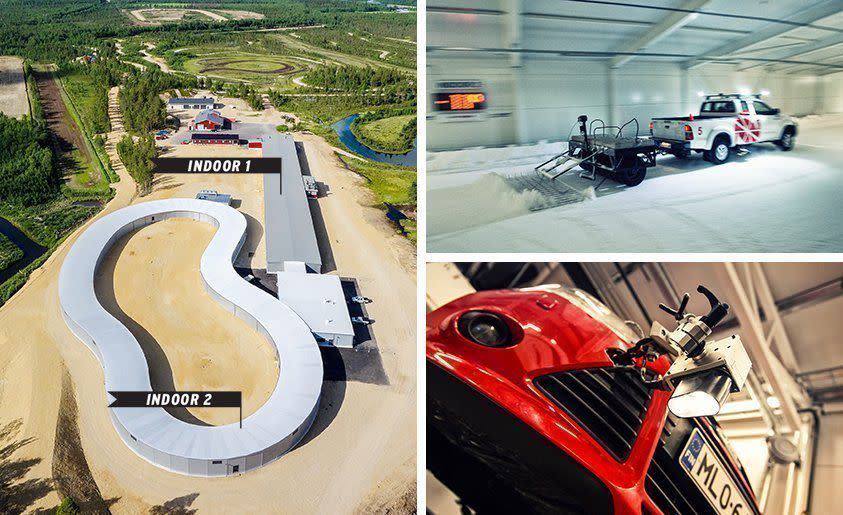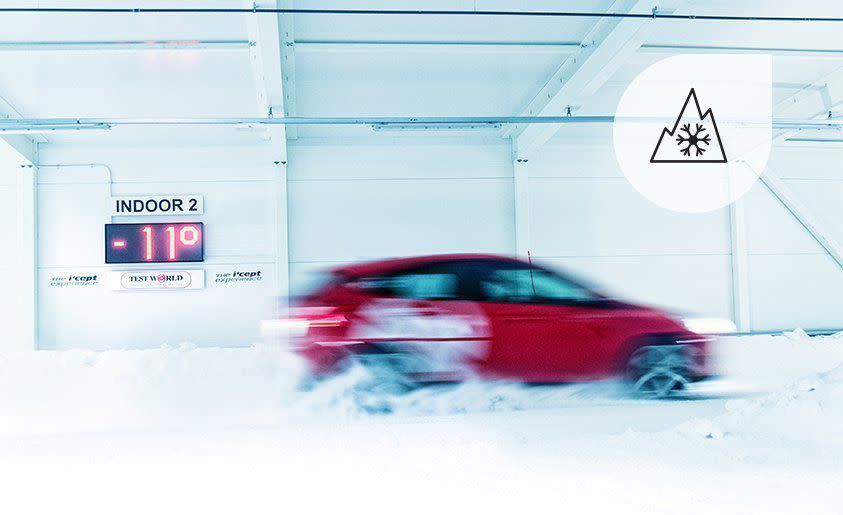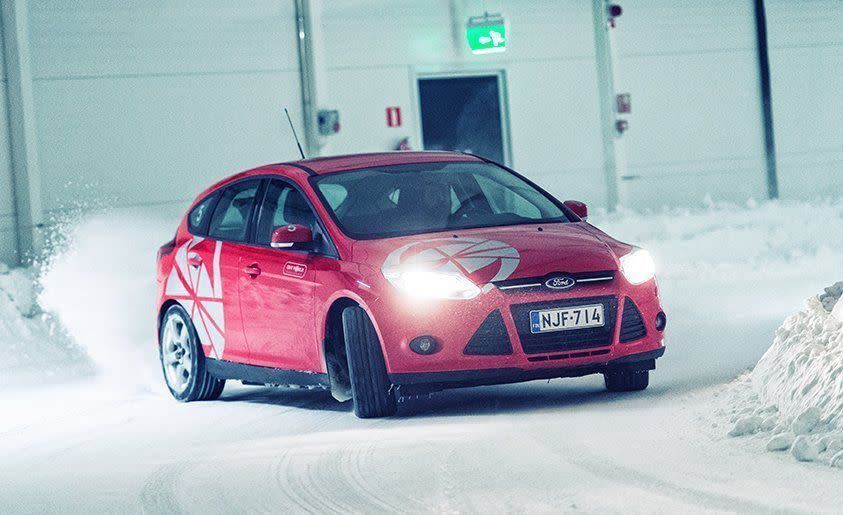Winter-Tire Test: Six Top Brands Tested, Compared

From the December 2015 issue
Assuming you don’t read Suomi, the language of Finland that sounds like a mashup of Dutch and Klingon, there are few road signs you will understand when you’re 186 miles above the Arctic Circle. But one announcing that Murmansk, Russia, is 188 miles away gets your attention, reminding you just how far north you are. Murmansk is a Cold War relic on the Arctic Ocean-to Soviet submarine warfare what Cape Canaveral is to spaceflight. These days, the Russian Northern Fleet occasionally moors nearby.
Then another sign we can read pops up on the left: “Test World Oy.” Oh yeah, we’re here to test some winter tires. Murmansk will have to wait. We have a cold war of our own to deal with.
The Test World Mellatracks proving grounds is a facility that offers year-round testing on natural snow, as opposed to the man-made stuff. During winter months it operates like any other automotive proving grounds, but with frozen canals and snow-packed fields standing in for the concrete and asphalt you find at more-temperate venues. In early spring, Test World stockpiles snow, filling its two buildings with about two feet of packed, natural white stuff, enough to last the entire indoor-testing season. We headed up to the refrigerated covered complex in late summer, as we wanted this story to appear in time for you to take advantage of its findings for the winter soon to be upon us.
The Indoor 1 building is a 525-foot-by-52-foot pole barn of packed snow that includes a lane of Zamboni-maintained ice. Indoor 2 contains a 0.2-mile, 30-foot-wide squiggly handling circuit. Both buildings have cooling circuits in the floor and chilled forced-air ductwork. On our test day, the inside thermometer read -11, as in degrees Celsius, or 12 degrees Fahrenheit.
Only 25 percent of snowbelt drivers fit their vehicles with winter tires, while Quebec and many European countries make them compulsory.
Indoor 1’s maximum speed is relatively slow: Braking tests on snow and ice are from 18 and 16 mph, respectively, down to 3 mph. The acceleration tests are just the opposite. Eliminating the zero-to-3-mph range for both going and stopping is a way to test around widely varying performance at low speeds on low-friction surfaces, attributable to differences in driver inputs as well as ABS behavior.
Indoor 2 is where the real fun happens. From the air, it looks like a giant hollow Jelly Belly. Its top speed of 45 mph on snow feels like triple digits in the dry. Get a corner wrong or slide too much and you’ll hit a strategically placed snowdrift, there to catch the car before the Armco does. Because “Indoor 2 subjective handling test” is a mouthful, we’ll just call it the “snowcross” test. Between each tire session, a maintenance crew resurfaces the snow to keep conditions as constant as possible. Also, a control tire laps periodically to normalize results if the track becomes faster or slower.
For this test we wanted to determine the best-performing studless snow-and-ice tire. As with past tire tests, we deferred to experienced drivers, this time supplied by Test World, for the objective acceleration and braking on snow and ice. We also partnered with our hosts for the subjective evaluation conducted on the indoor snowcross circuit and measured in lap times. Our mule was one of Test World’s Ford Focuses fitted with 225/45R-17 rubber.
These tires rely on their construction, rubber compounds, tread design, and what occasionally feels like magic to generate grip at the contact patch. Almost all tire manufacturers make a tire in this category, which is targeted mostly at family sedans and hatches. But we limited our testing to the heavy hitters: tires from Bridgestone, Continental, Dunlop, Michelin, Nokian, and Yokohama.
Only 25 percent of snowbelt drivers fit their vehicles with winter tires, while Quebec and many European countries make their use compulsory. This tire war won’t have the impact of the real Cold War, but if you are among the three-quarters of drivers who don’t use a set of cold-weather tires, we hope to change your thinking.
Your Best Foot Backward
No one recommends you install just two winter tires. If you must for reasons of cost, though, the conventional wisdom is that you want the best shoes (or the least worn) in the rear no matter if you have a front-, rear-, or four-wheel-drive vehicle. To confirm or bust this bias, we mixed two sets of Michelin tires, winter and all-season [see “Seasoned Perspective,” below], and ran a few laps of the snowcross with the all-seasons in front and the winters on the back, then vice versa. Conclusion: Putting the winter tires on the front wheels was a lot more fun. Not only was the grip-in-front car easier to steer and brake, it was also 3.2 seconds quicker around the little circuit at Test World. But that lap came with a wallop of oversteer, the kind of rear-end looseness that would catch most drivers out and toss them right into the ditch. Putting the winter tires at the rear yielded stubborn understeer, which is way more predictable than the alternative. So if you’re going to mix tires, for safety’s sake put your best rubber at the rear.
Service Description Decoder
The number indicates the maximum weight each tire can safely carry:
91=1356 LB
94=1477 LB The letter indicates the maximum speed the tire can safely travel:
R=106 mph
T=118 mph
H=130 mph
Y=186 mph
Extra-load tires are capable of carrying more weight at a higher air pressure than a similarly sized tire.
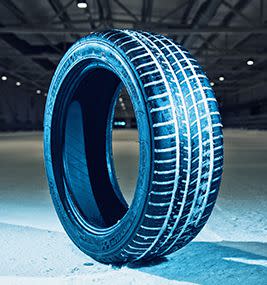
Seasoned Perspective
You may think you don’t need winter tires because your car has all-seasons. But, ironically, if you live somewhere that actually has all the seasons, you need winter tires. For perspective on this issue, we asked Michelin for a set of all-seasons, and it sent over its Pilot Sport A/S 3. If we were going to buy an all-season tire, it would be this one, because it actually has some serious dry grip in summer conditions. But as good as it is, the Pilot Sport was nearly six seconds off the Nokian’s pace on the snowcross, and it didn’t come close to any of the winter tires’ braking performances. On the snow, it took five feet more to stop than the average of the six winter tires on the following pages. Five feet may mean the difference between a fender bender and an accident-free winter. Braking distances on snow may be the best reason to fit a set of winter tires, and Inuit stoplight drag racers would do well to note the extra second of acceleration from 3 to 18 mph.
Michelin Pilot Sport A/S 3
Service Description: 91Y
Load: Standard
Tread Depth, in: 10.5/32
Price Per Tire: $144
-

Test Results
Snowcross Lap Time: 35.25 sec
Snow Acceleration, 3–18 mph: 4.48 sec
Snow Braking, 18–3 mph: 38.3 ft
Ice Acceleration, 3–16 mph: 11.99 sec
Ice Braking, 16–3 mph: 52.6 ft
Winter-Tire Test: View Results
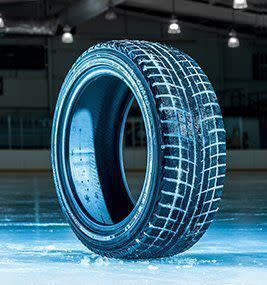
6. Yokohama
iceGUARD iG52c
Service Description: 91T
Load: Standard
Tread Depth, in: 11/32
Price Per Tire: $126
-
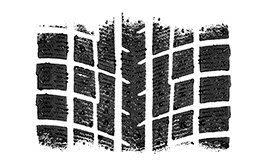
Last place in this test is like coming in sixth place in the Olympics. Yes, there are better performers, but this rubber is still pretty amazing. The iceGUARD iG52c is far better in winter conditions than any all-season tire on the road.
The iceGUARD’s largest point loss came on the snowcross [see here], where it showed the very desirable trait of progressiveness-turning and braking in a linear manner. It’s a calm tire, never losing or gaining grip unpredictably. That said, the iG52c’s overall lack of maximum traction put it nearly two seconds behind the quickest tire in the snowcross, which is a massive gap on a 30-second track.
It also fell short in the straight-line tests, taking the fewest points in all but ice acceleration, where it barely nudged the fifth-place Dunlop. The gaps in this test are, for the most part, small because of the slow speeds; they would grow exponentially with pace.
The biggest thing the iG52c has going for it is price. It’s the least expensive tire in the test. Many balk at the cost associated with winter tires; not just the rubber but the fitting or the second set of wheels. That winter-tire use extends the life of summer tires is often overlooked. Sure, soft winter compounds wear faster than summer or all-season tires, but the benefits are well worth the investment, no matter which winter tires you purchase, including this Yoko.
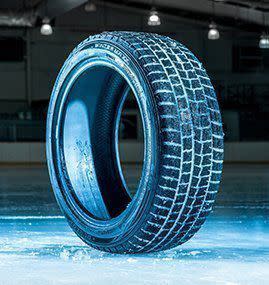
5. Dunlop
Winter Maxx
Service Description: 94T
Load: Extra
Tread Depth, in: 12/32
Price Per Tire: $134
-
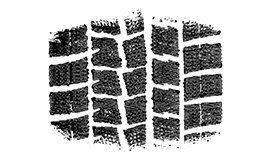
Unlike every other tire in this test, the Dunlop Winter Maxx has an asymmetrical tread pattern, meaning that, as opposed to a directional tire, it has dedicated inner and outer tread blocks. Winter tires produce more road noise than summer tires, and asymmetrical designs are usually quieter. But asymmetrics are mostly reserved for the “performance winter” class, where there’s more emphasis on a tire’s dry abilities.
We’re not sure its design led to this tire’s near-basement finish, but the straight-line objective tests don’t lie, and finishing last in three out of four tests is too much to overcome. The worst score came in ice acceleration, with the Dunlop trailing 1.29 seconds behind the winner. The Dunlop’s snow braking is impressive, however, with a distance just half a foot longer than the Bridgestone and Nokian.
Somehow, with the worst score in all the objective tests but snow braking, the Maxx still turned a pretty quick lap, 29.74 seconds, nearly tying the second-place finisher. Of note: When surpassing the limit in a corner, the Dunlop required some patience in its recovery, and there is a pronounced delay from input at the wheel or pedals to reaction at the surface.
Each Winter Maxx is $8 more than the Yokohama. If you’re on a budget and averse to road noise, it’s worth considering the Winter Maxx. But if you want more performance, keep reading.
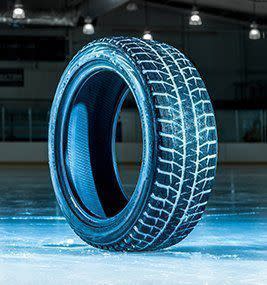
4. Bridgestone
Blizzak WS80
Service Description: 91H
Load: Standard
Tread Depth, in: 12/32
Price Per Tire: $160
-
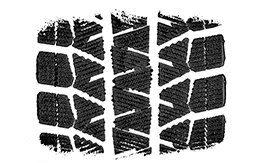
Blizzak is a familiar name, synonymous with winter-rubber excellence. We’ve been putting WS-series Blizzaks, starting with the WS15, on our long-term cars since the product line came to the U.S. in 1993. Thus, the WS80’s fourth-place finish shocked us.
Fortunately, the WS80’s major highlight is one of the more desirable traits for a winter tire: stopping in the snow. A large part of snow traction, specifically longitudinal accelerating and braking, comes from snow building up and packing in the tread. The resulting snow-on-snow contact increases grip, allowing the WS80 to tie our winner in snow braking. Hydrophilic passages, or holes in the tread that remove the microscopic layer of water that exits on ice, helped the WS80 tie the Conti at midpack for ice-braking scores.
Unfortunately, the WS80 posted the second-slowest snowcross time.
We thought it had some of the worst at-the-limit behavior by abruptly losing grip with little progressivity and a lengthy recovery time.
Bridgestone says it invests more than $1 billion a year in research and development, and winter tires are a big part of that. But there is a noticeable step up in performance from fourth to third in this test, and we hope Bridgestone’s engineers will close the gap with the next-generation WS.
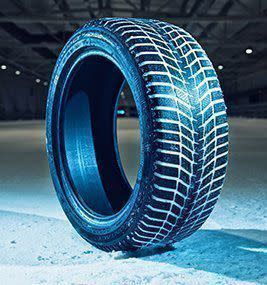
3. Continental
WinterContact Si
Service Description: 94H
Load: Extra
Tread Depth, in: 10/32
Price Per Tire: $131
-
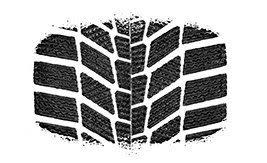
This is the newest tire in the test and among the most affordable. It’s an amazing value, falling but six points short of the winner. Even if you take cost out of the equation, it’s still an amazing piece of winter equipment.
As with all the other tires here, it has thousands of sipes to act as biting edges on ice. All the tires feature circumferential grooves (with the exception of the Nokian) and large channels to pump water and slush from the contact patch.
Excellent acceleration control exiting corners is a large contributor to this tire’s second-quickest lap time, and the Continental felt stronger than the second-place Michelin in this regard, but still inferior to our winner. The WinterContact also exhibited even and progressive limit behavior, breaking away and returning to grip predictably via steering and throttle manipulation.
However, we had to brake a little earlier on the quick part of the snowcross, which lowered overall driver confidence. This was particularly alarming because the Conti came out of the corners so well and therefore carried greater speed. A lowest-in-test snow-braking score confirms our subjective findings.
Falling short in just a single subjective measurement, this tire rises to the top tier of winter rubber with its accurate steering, near-best snow acceleration, and attractive price.
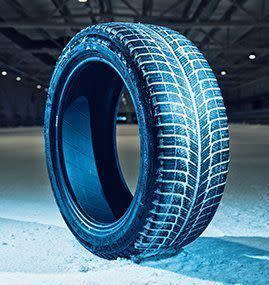
2. Michelin
X-Ice XI3
Service Description: 94H
Load: Extra
Tread Depth, in: 10.5/32
Price Per Tire: $152
-
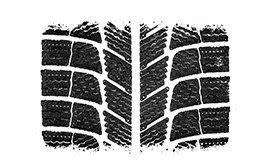
Tire development is an agonizingly slow process. A Michelin engineer told us recently that, after exiting Formula 1 racing in 2006, the company is just now trickling that technology down into its workaday road tires. We’ve put many sets of XI2s, the XI3’s predecessor, on cars in our 40,000-mile long-term fleet, and the difference in feel between the two generations is remarkable.
Subjectively speaking, the XI3 finishes second only to the Nokian. A slight reduction in control versus the Hakkapeliitta in sharper corners indicates that the XI3’s square edges, which all the winter tires in our test have, don’t work quite as well as the Nokian’s. Laps feel quick but also quite a bit looser, requiring a lot more driver effort to keep the car under control. Also, on-throttle understeer-most apparent when attempting to power out of a corner-is ever so slightly more pronounced here than with the Nokians. Despite these minor complaints, noticeable mostly in this controlled comparison setting, the XI3 remains a very well-balanced tire on snow and ice.
The XI3 scored evenly with the Nokian in three objective tests: snow acceleration, snow braking, and ice braking, while taking a one-point hit on ice acceleration. In terms of objective results, the first- and second-place tires are essentially the same.
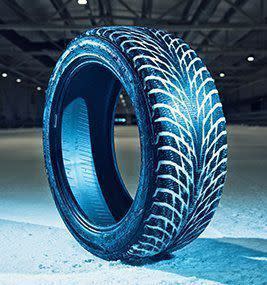
1. Nokian
Hakkapeliitta R2
Service Description: 94R
Load: Extra
Tread Depth, in: 11/32
Price Per Tire: $200
-
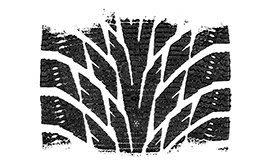
This tire is a bit of a dark horse. Finland’s Nokian, the 19th-largest tire manufacturer in the world, is probably unknown to many readers. Bridgestone is No. 1. Dunlop, Continental, and Yokohama are household names, and Michelin is a performance-tire behemoth. While it makes summer tires, Nokian specializes in winter-tire manufacturing, and it shows.
All the development, ongoing since Nokian introduced the first dedicated winter tire 81 years ago, translates into a tire that outperformed or tied its competitors in every test, objective or subjective. In some cases, the margin of victory was narrow, as in ice acceleration, where it bettered the XI3 by a mere 0.17 second. But a win is a win.
The most eye-opening trait of this Hakkapeliitta R2 is the way it steers on the snow and recovers from understeer. As steering angle increases, the R2 continues to turn the car where the other tires give up. Get into the push, dial it back a few degrees, and the grip returns. It feels more like a summer tire in the wet than a winter tire in the snow. And saying Hakkapeliitta out loud is nearly as enjoyable as driving them.
The one category this tire didn’t win is price. In this size, the R2 costs $48 more per tire than the second-place Michelin. That’s a bitter pill when you are talking about something most drivers consider a wintertime luxury. But we don’t. If the best winter traction is what you want, and you can afford the premium, look no further.
Winter-Tire Test: View Results
Test ResultsSNOWCROSS
LAP TIME, secSNOW ACCELERATION, 3–18 mph, secSNOW
BRAKING, 18–3 mph, ftICE
ACCELERATION, 3–16 mph, secICE BRAKING, 16–3 mph, ftBridgestone30.153.4833.37.3437.8Continental29.523.4634.57.2838.2Dunlop29.743.5533.88.3139.1Michelin29.733.4133.57.1936.3Nokian29.433.4033.37.0236.0Yokohama31.173.5334.78.0038.9
Final ResultsSNOW-
CROSS
LAP TIMESNOW ACCELER-
ATIONSNOW
BRAKINGICE
ACCELER-
ATIONICE BRAKINGPRICESUBJEC-
TIVE RATINGGRAND TOTALMax Pts. Available402020202010201501. Nokian40202020204201442. Michelin38202019208181433. Continental391918181710171384. Bridgestone36182018177141305. Dunlop38171912169161276. Yokohama30171814161014119
The name Hakkapeliitta dates to a 15th-century Finnish battle cry and roughly translates to “Hit them hard.”
('You Might Also Like',)

 Yahoo Autos
Yahoo Autos 